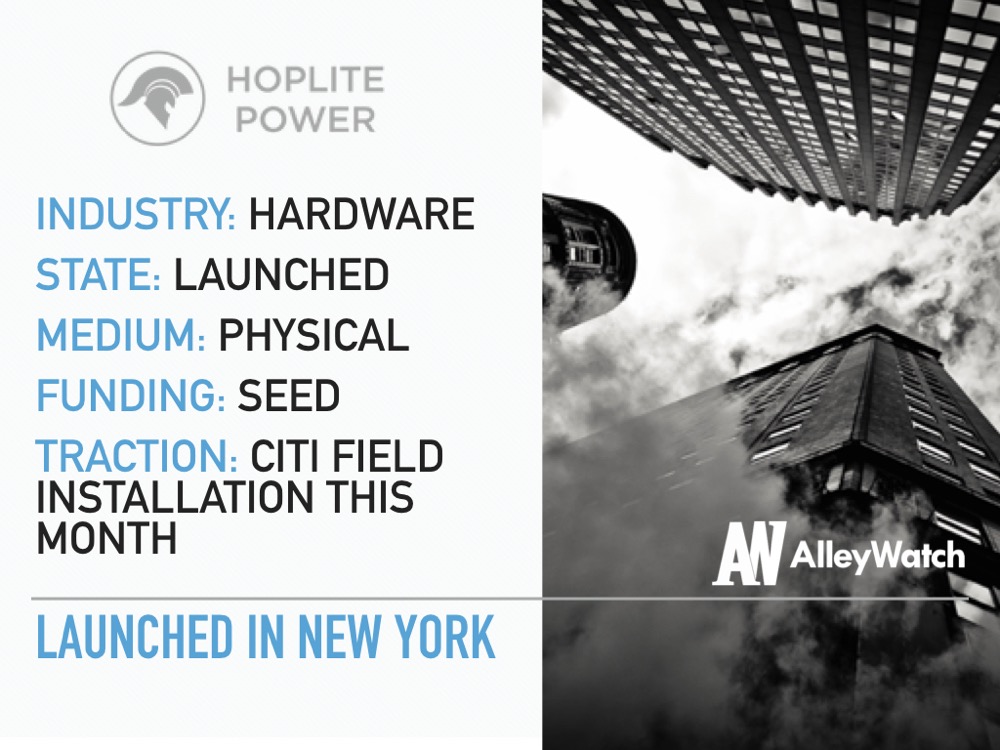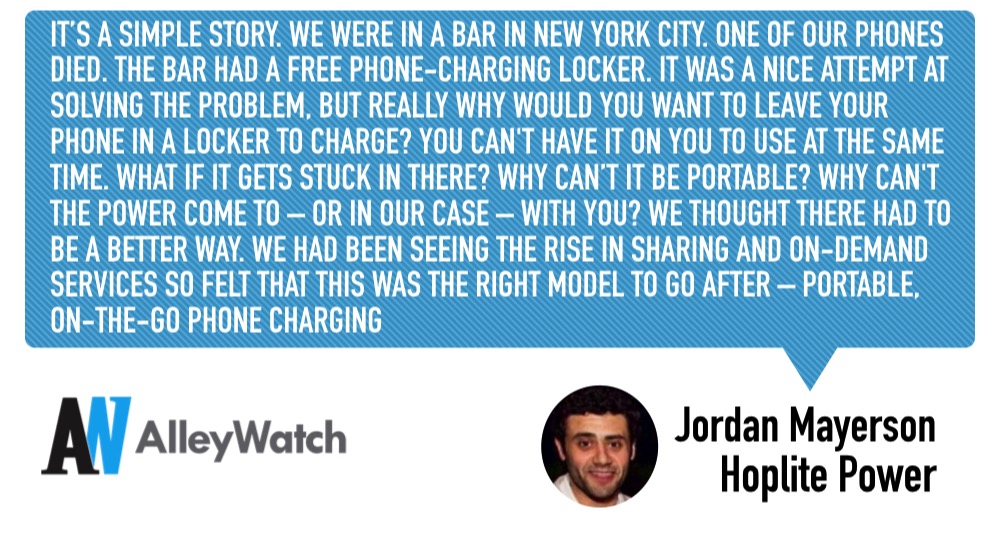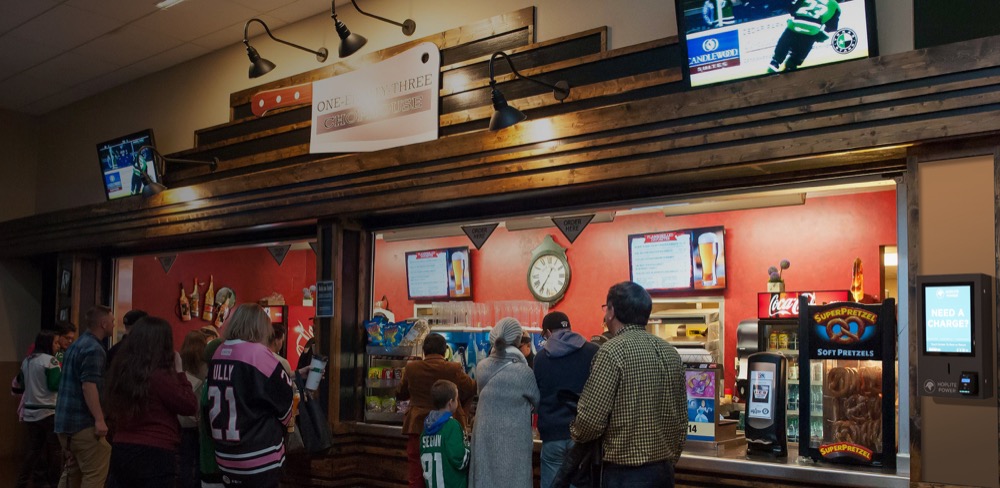How many times do you hear the statement (or excuse), “my phone died” uttered every day? Our guess, it’s a lot. To address this, Hoplite Power has built a network of kiosks that offer universal rechargeable battery packs that you can take from place to place to ensure you have power on-the-go. The kiosks are perfect for high traffic locations and venues including sports arenas, stadiums, and theme parks, where it’s estimated that 750 million people visit each other. For a few dollars, Hoplite ensures you have enough juice to Insta, Snap, or Facetime all the time.
AlleyWatch sat down with cofounder and CEO Jordan Mayerson to learn more about the inspiration for Hoplite Power, the company’s first installation at Citi Field, and future plans.
Tell us about the product or service that Hoplite Power offers.
We’ve developed a solution for the constant problem of being out of juice on your phone whenever it seems like it’s the worst possible moment.
We’ve created kiosks offering universal rechargeable battery packs that you can then take from place to place. Think of it as a bike-share – but instead of sharing bikes you’re sharing battery packs. Our second-generation kiosks will actually recharge the batteries on the inside making the operation even more streamlined.
How is Hoplite different?
The way we view ourselves is that we created something that services the needs of all parties involved – whether it be the consumer who is looking to charge their phone or the venue or business in which one of our kiosks is installed. The vended battery pack guarantees visitors’ phones are fully charged. You can access the charger when you need it. You don’t need to bring a charger with you or find an outlet. You don’t need to bring an external battery pack with you everywhere you go. Rent a battery pack and move about your business.
 What market does Hoplite Power target and how big is it?
What market does Hoplite Power target and how big is it?
We can really go after any large venue where there’s a lot of foot traffic and a desire by attendees to be on their phones. Our primary focus for now though is the sports market, which we see as the best fit. We can also see this expanding to transit, hospitality and other entertainment venues like large theme parks and concert halls. Basically anywhere where there’s a mass of people moving about and need to have a functional phone.
Between sports venues and theme parks alone, the number of annual visitors is around 750 million people. That’s a massive market opportunity. If there are 750 million people going through these various entrances on a yearly basis, just think how many of them need to be powered up. If we can get a very small fraction of that market size, our business will be booming – that’s the hope, of course!
What is the business model?
We try to keep it as simple as possible. We are a charging service so there is a fee to the end-user. When you rent a charger you pay a nominal rental fee, which is between $3.99-$4.99 depending on location for a 24-hour rental.
You’re then able to then take the battery pack and return to any kiosk in our network once you’re finished. If the battery pack is returned late or damaged, there are associate penalty fees in accordance with our terms and conditions. So the rental revenue we generate from our users is from the actual battery packs themselves.
On the B2B side and with our location partners, as of right now, there are no upfront costs. While it could change as we scale, we come in and install the kiosks. We maintain operational control and ownership of the kiosks themselves. We participate in a negotiated revenue share with a particular venue or business. This includes revenue on the rental itself in addition to any advertising, sponsorship or branding that’s placed on our Hoplite Hubs or the battery packs.
What inspired the start of Hoplite Power?
It’s a simple story. We were in a bar in New York City. One of our phones died. The bar had a free phone-charging locker. It was a nice attempt at solving the problem, but really why would you want to leave your phone in a locker to charge? You can’t have it on you to use at the same time. What if it gets stuck in there? Why can’t it be portable? Why can’t the power come to – or in our case – with you? We thought there had to be a better way. We had been seeing the rise in sharing and on-demand services so felt that this was the right model to go after – portable, on-the-go phone charging.
How do you source the hardware installations needed for your service and mitigate costs?
All the hardware has been developed in-house. We designed the kiosks. We designed the battery packs. Everything that has been developed to date has been designed, built, operated, and serviced in-house. That’s how we are planning on it working moving forward as well. We want to maintain a certain level and quality of service. The best way to do that is to keep the manufacturing within our organization.
What are the milestones that you plan to achieve within six months?
The first big one is getting the Hoplite Hubs installed at Citi Field. This is our first professional sports client, which we’re thrilled about. So that’s our number one priority. We’re targeting doing another installation or two with other sports venues by the end of the year as well. We’ll also be raising capital in the coming months. It’s definitely an exciting time for us.
What is the one piece of startup advice that you never got?
Not to sound cynical, but nobody ever tells you as hard as you think starting a company is going to be, you really have no idea just how difficult it actually is.
If you could be put in touch with anyone in the New York community who would it be and why?
Someone at Madison Square Garden. I want Hoplite Hubs in MSG and they keep ignoring my e-mails! Or someone at Yankee Stadium for that matter. Those are two of the premier sports facilities in the country right here in our backyard. We want to break into them.
Why did you launch in New York?
We currently have a 16-unit pilot running in a few bars in Manhattan and Brooklyn with our first-generation machine to test the market and see people’s willingness to pay for power. Given the demographic makeup and New York City lifestyle, it made perfect sense to launch here.
We currently have a 16-unit pilot running in a few bars in Manhattan and Brooklyn with our first-generation machine to test the market and see people’s willingness to pay for power. Given the demographic makeup and New York City lifestyle, it made perfect sense to launch here.
Everyone’s on the go and on his or her phones. Nobody has time to be tethered to a wall charger. There’s a bar every five feet in the city. The city is bustling at all hours of the night. So we felt it would be the best market to start testing.
What’s your favorite restaurant in the city?
Since I cook, I’d have to say my own apartment.






